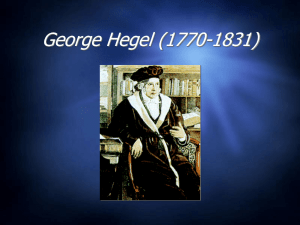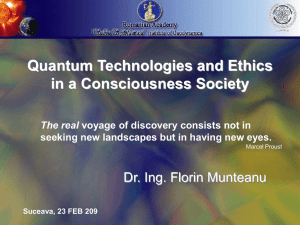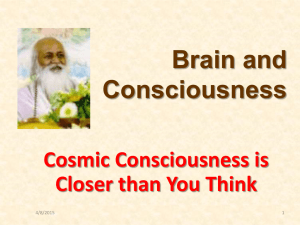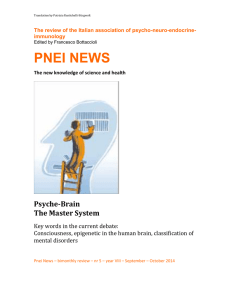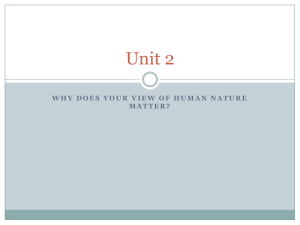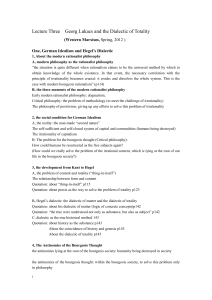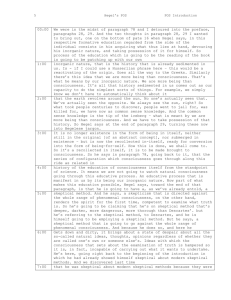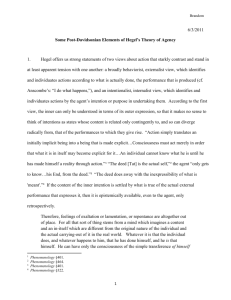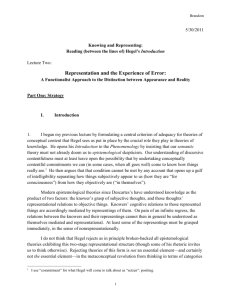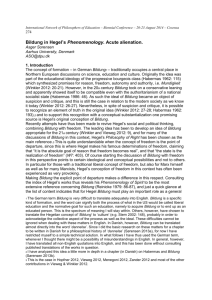PPT Slides - Deontologistics
advertisement
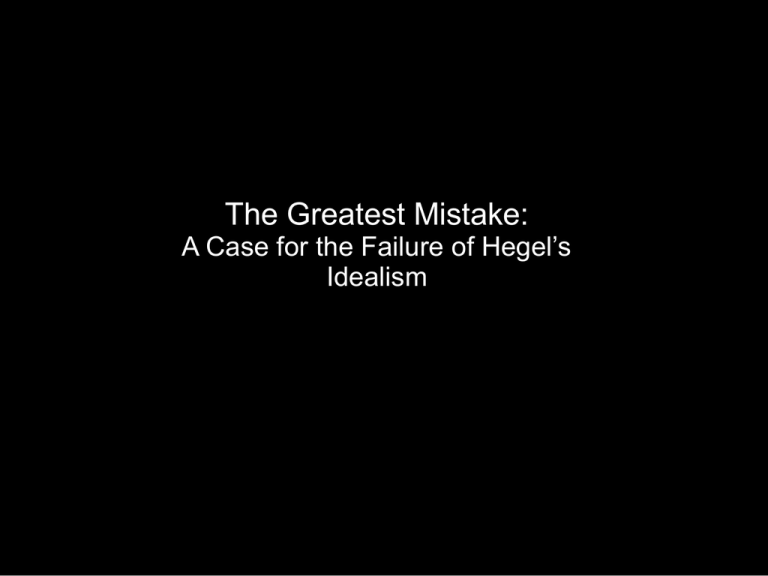
The Greatest Mistake: A Case for the Failure of Hegel’s Idealism Four Questions - What is a great mistake? - What is Absolute Idealism? - Why is Hegel an Absolute Idealist? - Where does Hegel go wrong? What is a great mistake? 1. It is an error from which we can learn. 2. We gain understanding by explaining why it is an error. 3. This means either:- i) It forces us to make explicit our previously vague intuitions. ii) It forces us to acknowledge genuinely counterintuitive results. What is Absolute Idealism? We must distinguish between Absolute Idealism and Subjective Idealism. The Identity Thesis: the subject and the object are identical. Berkeley’s Maxim: esse ist percipi – to be is to be perceived or thought about. Three Forms of Identity Terms Role Unity subject / object method Absolute Knowing thought / Being system Absolute Idea subject / substance reality Absolute Spirit Hegel and Heidegger Unity Structure Role Content Absolute Idea general beings as such subjects in general Absolute Spirit singular beings as a whole highest subject Hegel is an onto-theologian because he thinks what Heidegger calls Being – the unified structure of beings as such and as a whole – in terms of specific beings. This explicitly violates the ontological difference. Science as Method The identity thesis as method = Absolute Knowing = Science Hegel claims that the Science of Logic is presuppositionless. This is true in a limited sense: the identity thesis does not function as a premise. The identity thesis functions as a methodological presupposition in two ways:i) It determines a deductive procedure. ii) It provides the schema for interpreting its results. The Structure of the Logic The Basic Dialectic: the linear progression of categories: Being, Nothing, Becoming, etc., ...Absolute Idea. The Division of Books: the threefold separation into the Doctrine of Being, the Doctrine of Essence, and the Doctrine of the Concept. The Division of Volumes: the twofold separation into the Objective Logic, which includes both Being and Essence, and the Subjective Logic, which includes the Concept. The Overall Dialectic: the complete transition from Being to Absolute Idea. Science as Deductive Procedure Science as deductive procedure is dialectic. It constitutes a non-intentional form of thought in which we do not use pre-individuated concepts to form fixed propositions about particular objects. Instead, we think the content of concepts directly, allowing them to immanently transform themselves into other concepts by way of what Hegel calls speculative propositions. The logic explicates the structure of thought by beginning with the most minimal content that can be thought – immediate indeterminacy – or what Hegel calls Being. Science as Interpretational Schema Science as interpretational schema determines the Logic as both a logic and a metaphysics. Logical Categories = Metaphysical Categories It also grounds the interpretation of the Logic as theology. Why is Hegel an Absolute Idealist? The Phenomenology is what justifies the standpoint of the Logic. The Phenomenology is motivated by responding to skepticism, and the transcendental response to skepticism. The Problem of Transcendental Method: responding to skepticism by analysing the structure of knowledge in terms of its conditions of possibility presupposes the possibility of knowledge about knowledge. Pyrrhonian Skepticism Pyrrhonianism is the most extreme form of skepticism, and it can be described in two equivalent ways. The Problem of the Criterion: how can we find a criterion for choosing between a proposition and its negation (P and not P) that does not itself require a criterion to be justified? The Agrippan Trilemma: how is it possible to justify any proposition (in contrast to its negation) without either:a) merely asserting its truth (bare assertion)? b) appealing to another proposition that itself must be justified (regress)? c) justifying it by appeal to itself (circularity)? Leveraging Skepticism The Problem of Transcendental Method (cont.): the transcendental philosopher must presuppose that knowledge is possible in order to describe its conditions of possibility. Hegel’s Solution: if we bracket the possibility of knowledge we may describe knowledge as it appears. This is precisely what Hegel does with his concept of Natural Consciousness. The Role of Natural Consciousness Natural Consciousness = the non-identity of subject and object. The Phenomenology is the self-contradiction of the concept of Natural Consciousness, which thereby transforms itself into its negation, the concept of Science. The Structure of Natural Consciousness 1) Consciousness relates itself to its object, or takes its object to be a certain way. What this means, is that it expresses a proposition about its object. 2) Consciousness distinguishes between this proposition and the object as it is in itself. In essence, consciousness allows for the possibility that this proposition is false. 3) Because consciousness itself makes the distinction between its claim and the object it is about, the object cannot be truly in-itself, but has two basic features:mustIt be for-consciousness. This means that consciousness must have a concept of its object in order to individuate it. 1) Consciousness relates itself to its object, or takes its object to be a certain way. What this means, is that it expresses a proposition about its object. 4) However, consciousness cannot be aware that the object is for-it without ceasing to be consciousness, and thus must suppress this fact. This means that consciousness cannot recognise that the concept of the object is dependent upon it without undermining the possibility of falsity. Natural Consciousness as Deductive Procedure Natural Consciousness as deductive procedure is ordinary discourse. This describes the form of intentional thought, in which we think about particular objects using fixed propositions composed of preindividuated concepts. This is opposed to Science as the form of non-intentional thought, in which we think the content of concepts directly. The Method of the Phenomenology The Phenomenology proceeds by a method of exhaustion. It does this by showing that each possible form of Natural Consciousness ultimately contradicts itself, thereby transforming itself into another possible form, until we have exhausted all possible forms. It thus demonstrates that if knowledge is conceived as Natural Consciousness, then it is impossible. The Structure of the Phenomenology The Basic Dialectic: the progression of various things consciousness purports to know about its object. This is a series of propositions, beginning with the sequence in Sense Certainty: ‘This is here and now’, ‘This is here and now for me’, etc., and ending in the identity thesis. The Division of Forms: the forms of consciousness, such as Sense Certainty, Perception, Understanding, Self-Consciousness, etc. and ending in Absolute Knowing. The Division of Sections: the more general categories, such as Consciousness, Self-Consciousness and Reason. The Overall Dialectic: This is the Phenomenology viewed as the justification of the Logic, or the transformation of the concept of Natural Consciousness into the concept of Science. The Phenomenology as Dialectic The Phenomenology is still a dialectic, albeit it one that consists in propositions that are purportedly absolute, rather than speculative propositions that are explicitly transitional. Each form of consciousness is a concept whose content is thought immanently by the method of exhaustion. These form a hierarchy of genus and species that correspond to the various higher level ways of dividing the dialectic. The concept of Natural Consciousness is the highest genus, with each level beneath is divided into mutually exclusive species. The Hierarchy of Concepts of Consciousness Natural Consciousness Consciousness Sense Certainty Self- Consciousness Perception Understanding Reason Absolute Knowing The dialectical movement at each level constitutes the dialectical movement of the level above.
